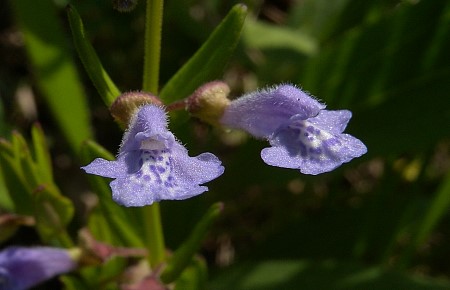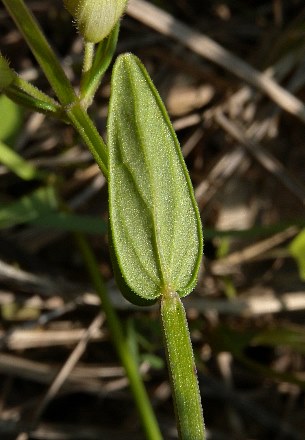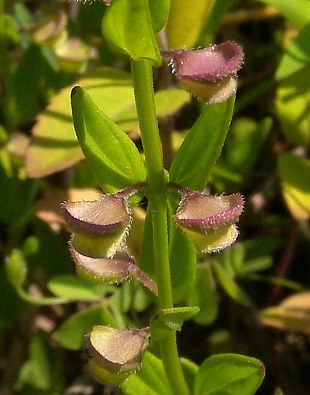Description: This small wildflower is 3-9" tall. Sometimes it branches from the base, otherwise the stems are unbranched. The stems are light green, 4-sided, and slightly to moderately hairy, especially along the angles of the sides. Pairs of opposite leaves occur along the stems. The leaf blades are ½–¾" long and about one-half as much across; they are lanceolate, ovate, or oval, while their revolute margins are smooth to crenate with a few blunt teeth. Generally, the upper leaves are more slender and less likely to have teeth than the lower leaves. The upper leaves are sessile, while the lower leaves have short petioles about 1/8" (3 mm.) long. The upper leaf surface is medium green and hairless to sparsely pubescent, while the lower surface is pale green and sparsely to densely pubescent. In this variety of Small Skullcap, all of the hairs lack sticky glandular secretions.

Individual flowers
develop from axils of the upper leaves; this occurs along the upper
half of each plant. Each flower is about 1/3" (8 mm.) long, consisting
of a
tubular corolla with upper and lower lips, a short 2-lipped calyx, 4
stamens, and a pistil with a single style that is cleft at its tip. The
corolla is light blue to blue-violet, except for a white patch on the
lower lip that is covered with blue-violet dots. The upper lip is short
and recurved along its margin, while the lower lip is long and usually
divided into 3 lobes with undulate margins. The calyx is usually
greenish red and hairy; there is a prominent protuberance along the
back of its upper lip. The pedicels are about 1/8" (3 mm.) long,
greenish red,
and hairy. The blooming period occurs from late spring to early summer
and lasts about 1½ months. On each plant, only a few flowers are in
bloom at the same time. In addition to these flowers, there are also
cleistogamous flowers that are self-fertile and inconspicuous. The
flowers are replaced by 2-lipped seed capsules with concave upper
sides. At maturity, the capsules split open into 2 parts to release the
seeds. Individual seeds are about 1 mm. long, ovoid, and indented on
one side; their surfaces are covered with minute spiky tubercles. The
root system produces rhizomes with tuberous swellings at intervals.
This wildflower can spread vegetatively by the rhizomes, or it can
reseed itself.
Cultivation:
The preference is full or partial sun, dry conditions, and shallow soil
containing some sandy or rocky material. This wildflower will adapt to
sunny rock gardens and does not tolerate much competition from taller
plants.

Range & Habitat:
This variety of the native Small Skullcap is occasional in the northern
half of
Illinois and uncommon in the southern half of the state (see Distribution
Map). Habitats include hill prairies, upland prairies, gravel
and sand prairies, barren savannas, thinly wooded bluffs and slopes,
rock ledges, limestone glades, and abandoned fields. Small Skullcap
usually occurs where the ground vegetation is somewhat sparse, and it
probably benefits from occasional wildfires.
Faunal Associations:
The flowers are cross-pollinated by various bees, including Mason bees (Osmia
spp., Hoplitis pilosifrons), Little
Carpenter bees (Ceratina spp.), and Halictid bees (Halictus
spp., Lasioglossum spp.). Bees usually
suck nectar from the flowers, although some of them also collect
pollen. Less common floral visitors include skippers and Syrphid flies,
which are less effective at cross-pollination. Insects that are known
to feed on the foliage of Small Skullcap include the caterpillars of Prochoreutis
inflatella (Skullcap Skeletonizer Moth), the leaf beetles Phyllobrotica
lengi and Phyllobrotica limbata, and Asphaera
lustrans (Shiny Flea Beetle). The foliage of Scutellaria
spp. (Skullcaps) are usually bitter and avoided by mammalian
herbivores. It is possible that the tiny tuberculate seeds of Small
Skullcap, when they are wet, can cling to the feathers of birds, the
feet of animals, and the shoes of humans. By this means, they may be
distributed to new areas.
Photographic Location:
The Coneflower Hill Prairie near Lake Shelbyville in Moultrie County,
Illinois.

Comments: Small Skullcap is easily overlooked because of its diminutive size, but its flowers are very attractive when they are viewed up-close. The variety of Small Skullcap that is described here, var. missouriensis, has hairs that lack glandular secretions, while var. parvula and var. australis have foliage with some glandular hairs. Otherwise, these different varieties are similar to each other. Regardless of variety, Small Skullcap can be distinguished from other species in its genus by the small size of individual plants (3-9" tall), the small size of its flowers (about 1/3" long), and its form of inflorescence: flowers are produced individually from the axils of the leaves, rather than in terminal or axillary racemes. Scientific synonyms of Scutellaria parvula missouriensis include Scutellaria parvula leonardii and Scutellaria leonardii. As a result of these other scientific names, this variety of Small Skullcap is sometimes referred to as Leonard's Skullcap.